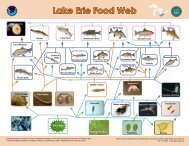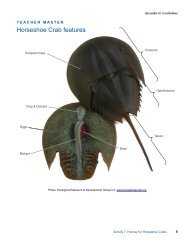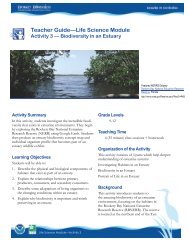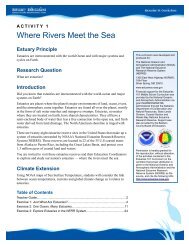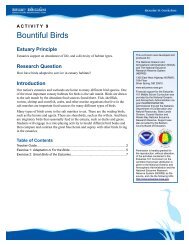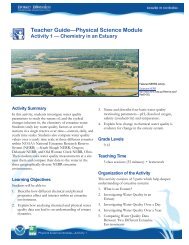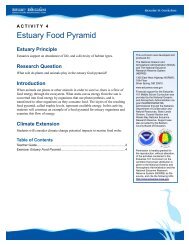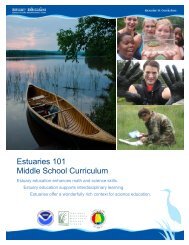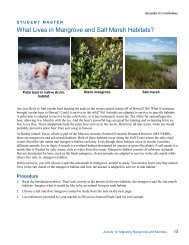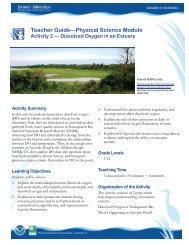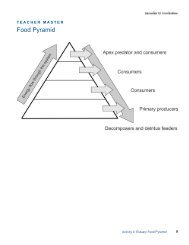The Great Oyster Mystery Teacher Guide - Estuaries NOAA
The Great Oyster Mystery Teacher Guide - Estuaries NOAA
The Great Oyster Mystery Teacher Guide - Estuaries NOAA
Create successful ePaper yourself
Turn your PDF publications into a flip-book with our unique Google optimized e-Paper software.
E X E R C I S E 2A Salty Tale of IntrigueEstuary ConceptExplain how the National Estuarine Research Reserve System Wide MonitoringProgram (SWMP) can provide real data for research on abiotic factors that affectoysters, such as salinity and precipitation.Focus QuestionHow can graphs of real data be generated to collect information about salinityand precipitation?Performance TasksStudents will:• Access and print real salinity and rainfall data from a two-year period duringwhich oyster abundance in the Mission-Aransas estuary declined and thenrebounded.<strong>Teacher</strong> BackgroundIn this exercise, students will access real data from the NERRS System wideMonitoring Program (SWMP). SWMP is used to monitor the health of thereserves. It measures changes in estuarine waters to record how human activitiesand natural events affect coastal habitats. Data-collecting instruments are locatedat over 100 data stations (about 4 stations at each reserve).OverviewStudents will access theNERRS System WideMonitoring Program (SWMP)data on the Estuary Educationwebsite to investigate changesin salinity and rainfall patternsthat occurred in Aransas andCopano bays during the studyperiod. Students will need thecollected data from thisexercise to use in Exercise 3,which is the final part of thisactivity.Time RequiredOne 45-minute class periodYou'll find multimedia and otherresources on the web page forthis activity in the Middle SchoolCurriculum section of theEstuary Education website:http://estuaries.noaa.gov.SWMP data stations collect data on a variety of factors. <strong>The</strong>re are stations thatrecord water quality data, including pH, salinity, oxygen saturation, and otherabiotic factors. Other stations record weather data, such as temperature andprecipitation. Still other stations record factors relating to biology, such asdissolved nutrients and concentration of chlorophyll in the water.Your students will be accessing the SWMP data through the online graphing toolon estuaries.noaa.gov. <strong>The</strong>y will create salinity and precipitation graphs to use indetermining why the oyster populations in Copano Bay and Aransas Baydeclined in 2007 and then increased in 2008.<strong>Teacher</strong> Preparation1. Practice accessing and using the graphing function for SWMP data beforeworking with students in Exercise 2. See instructions in Student Master:Clues in the Numbers.2. It is highly recommended that students go online to collect their own salinityand precipitation data. However, if this option is not available to you, you cangenerate a graph of the Water Salinity and the Precipitation Time Series forAransas Bay and Copano Bay ahead of time and have students copy data fromthat.Activity 11: <strong>The</strong> <strong>Great</strong> <strong>Oyster</strong> <strong>Mystery</strong> 11



